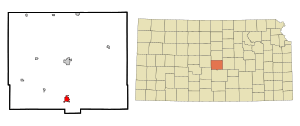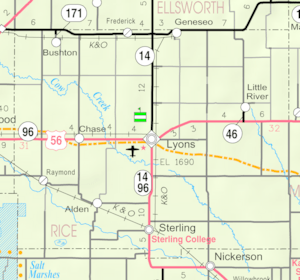Sterling, Kansas facts for kids
Quick facts for kids
Sterling, Kansas
|
|
|---|---|

Location within Rice County and Kansas
|
|

|
|
| Country | United States |
| State | Kansas |
| County | Rice |
| Township | Sterling |
| Founded | 1872 (Peace) |
| Incorporated | 1876 |
| Named for | Sterling Rosan |
| Area | |
| • Total | 1.83 sq mi (4.75 km2) |
| • Land | 1.79 sq mi (4.64 km2) |
| • Water | 0.04 sq mi (0.11 km2) |
| Elevation | 1,641 ft (500 m) |
| Population
(2020)
|
|
| • Total | 2,248 |
| • Density | 1,228/sq mi (473.3/km2) |
| Time zone | UTC-6 (CST) |
| • Summer (DST) | UTC-5 (CDT) |
| ZIP code |
67579
|
| Area code | 620 |
| FIPS code | 20-68200 |
| GNIS ID | 485654 |
Sterling is a city located in Rice County, Kansas, in the United States. In 2020, about 2,248 people lived there. Sterling is also home to Sterling College, a well-known school.
History of Sterling
For thousands of years, the land where Kansas is now was home to Native American people. In 1803, the United States bought a large area, including most of modern Kansas, in a deal called the Louisiana Purchase. Later, in 1854, the Kansas Territory was set up. Then, in 1861, Kansas became the 34th state in the United States. Rice County, where Sterling is located, was created in 1867.
Sterling was first called Peace when it was founded in 1872. In 1876, its name was changed to Sterling. Two brothers decided on this new name to honor their father, Sterling Rosan.
In the 1890s, a man named Jonathan S. Dillon sold groceries from his store in Sterling. Later, in 1913, he opened his first J.S. Dillon Cash Food Market in Hutchinson. This store eventually grew into the large Dillons grocery supermarket chain we know today.
Historic Places to Visit
Sterling has several buildings that are important to its history. These places are listed on the National Register of Historic Places (NRHP).
- Cooper Hall is on North Broadway Avenue.
- The Shay Building is located at 202 South Broadway Avenue.
- The Sterling Carnegie Library is at 132 North Broadway Avenue.
Geography and Climate
According to the United States Census Bureau, the city of Sterling covers a total area of about 1.71 square miles (4.43 square kilometers). Most of this area, about 1.67 square miles (4.33 square kilometers), is land. A small part, about 0.04 square miles (0.10 square kilometers), is water.
Sterling's Weather Patterns
Sterling, Kansas, experiences a variety of weather throughout the year. Here's a look at the average temperatures:
| Climate data for Sterling, Kansas | |||||||||||||
|---|---|---|---|---|---|---|---|---|---|---|---|---|---|
| Month | Jan | Feb | Mar | Apr | May | Jun | Jul | Aug | Sep | Oct | Nov | Dec | Year |
| Mean daily maximum °F (°C) | 40.4 (4.7) |
47.2 (8.4) |
56.9 (13.8) |
67.1 (19.5) |
76.4 (24.7) |
87.4 (30.8) |
92.7 (33.7) |
90.9 (32.7) |
82.0 (27.8) |
70.2 (21.2) |
54.4 (12.4) |
43.4 (6.3) |
67.4 (19.7) |
| Daily mean °F (°C) | 29.3 (−1.5) |
35.0 (1.7) |
44.3 (6.8) |
54.2 (12.3) |
64.5 (18.1) |
75.1 (23.9) |
80.4 (26.9) |
78.6 (25.9) |
69.4 (20.8) |
57.2 (14.0) |
42.6 (5.9) |
32.5 (0.3) |
55.3 (12.9) |
| Mean daily minimum °F (°C) | 18.1 (−7.7) |
22.7 (−5.2) |
31.6 (−0.2) |
41.2 (5.1) |
52.5 (11.4) |
62.7 (17.1) |
68.0 (20.0) |
66.3 (19.1) |
56.8 (13.8) |
44.2 (6.8) |
30.8 (−0.7) |
21.5 (−5.8) |
43.0 (6.1) |
Population and People
The population of Sterling has changed over the years. Here's how many people have lived in the city during different census years:
| Historical population | |||
|---|---|---|---|
| Census | Pop. | %± | |
| 1880 | 1,014 | — | |
| 1890 | 1,641 | 61.8% | |
| 1900 | 2,002 | 22.0% | |
| 1910 | 2,133 | 6.5% | |
| 1920 | 2,060 | −3.4% | |
| 1930 | 1,868 | −9.3% | |
| 1940 | 2,215 | 18.6% | |
| 1950 | 2,243 | 1.3% | |
| 1960 | 2,303 | 2.7% | |
| 1970 | 2,312 | 0.4% | |
| 1980 | 2,312 | 0.0% | |
| 1990 | 2,536 | 9.7% | |
| 2000 | 2,642 | 4.2% | |
| 2010 | 2,328 | −11.9% | |
| 2020 | 2,248 | −3.4% | |
| U.S. Decennial Census | |||
Sterling's Population in 2010
In 2010, the census showed that 2,328 people lived in Sterling. There were 786 households, and 510 of these were families. The city had about 1,394 people per square mile.
Most of the people in Sterling were White (93.1%). There were also African American (2.4%), Native American (0.7%), and Asian (0.6%) residents. About 4.3% of the population identified as Hispanic or Latino.
About 27.9% of households had children under 18 living with them. Many households (52.7%) were married couples. The average household had 2.31 people, and the average family had 2.89 people. The median age in Sterling was 29.5 years.
Economy and Jobs
The biggest employer in Sterling is Jacam. This company makes special chemicals used in the oil and gas industry.
Education in Sterling
Local Schools for Kids
The Sterling USD 376 public school district serves the community. There are three schools in Sterling:
- Sterling High School is for students in 9th through 12th grade. It is located at 308 East Washington Avenue.
- Sterling Junior High School] teaches students in 7th and 8th grade. You can find it at 412 North 5th Street.
- Sterling Grade School] is for younger students, from Kindergarten to 6th grade. It is located at 218 South 5th Street.
Sterling College
Sterling College is a four-year school. It used to be connected with the Presbyterian Church USA. The college is one of the largest places to work in Sterling. The college's sports teams are called the Sterling Warriors. They play football games at Smisor Stadium and basketball games at the Clair L. Gleason PE Center.
City Infrastructure
Transportation in Sterling
Roads and Highways
K-14 and K-96 are major highways that run along the north side of Sterling. You can get to Broadway Avenue from these highways using a special exit.
Before June 2023, the highway went right through Sterling on Broadway Avenue. Now, it's a limited-access highway that goes around the city. It was built as a "super two" freeway, which means it has two lanes but is designed to be expanded to four lanes in the future.
Railroad Access
The Kansas and Oklahoma Railroad has tracks that pass through the city of Sterling.
Famous People from Sterling
Many notable people have connections to Sterling, Kansas.
- Doris Fleeson, a well-known journalist, was born in Sterling.
- Nicolle Galyon, a songwriter and singer who has won awards, grew up in Sterling.
- Lorene Harrison, a musician and educator, was born in Sterling.
- Martin Pence, who became a United States District Court judge, was born in Sterling.
- Richard G. Weede, a General in the United States Marine Corps, was also born in Sterling.
See also
 In Spanish: Sterling (Kansas) para niños
In Spanish: Sterling (Kansas) para niños

